Chapter: Mobile Computing : Mobile Telecommunication System
Global System for Mobile Communication
GLOBAL SYSTEM FOR MOBILE
COMMUNICATION (GSM)
GSM
stands for Global System for Mobile Communication. It is a digital cellular technology used for
transmitting mobile voice and data services. The concept of GSM emerged from a
cell-based mobile radio system at Bell Laboratories in the early 1970s. GSM is
the name of a standardization group established in 1982 to create a common
European mobile telephone standard.
GSM is
the most widely accepted standard in telecommunications and it is implemented
globally.GSM is a circuit-switched system that divides each 200 kHz channel
into eight 25 kHz time-slots. GSM operates on the mobile communication bands
900 MHz and 1800 MHz in most parts of the world. In the US, GSM operates in the
bands 850 MHz and 1900 MHz.
GSM owns
a market share of more than 70 percent of the world's digital cellular
subscribers. GSM makes use of narrowband Time Division Multiple Access (TDMA)
technique for transmitting signals. GSM was developed using digital technology.
It has an ability to carry 64 kbps to 120 Mbps of data rates. Presently GSM
supports more than one billion mobile subscribers in more than 210 countries
throughout the world.
GSM
provides basic to advanced voice and data services including roaming service.
Roaming is the ability to use your GSM phone number in another GSM network.GSM
digitizes and compresses data, then sends it down through a channel with two
other streams of user data, each in its own timeslot.
Why GSM?
Listed
below are the features of GSM that account for its popularity and wide
acceptance.
·
Improved spectrum efficiency
·
International roaming
·
Low-cost mobile sets and base stations (BSs)
·
High-quality speech
·
Compatibility with Integrated Services Digital
Network (ISDN) and other telephone company services
·
Support for new services
GSM History
The
following table shows some of the important events in the rollout of the GSM
system.
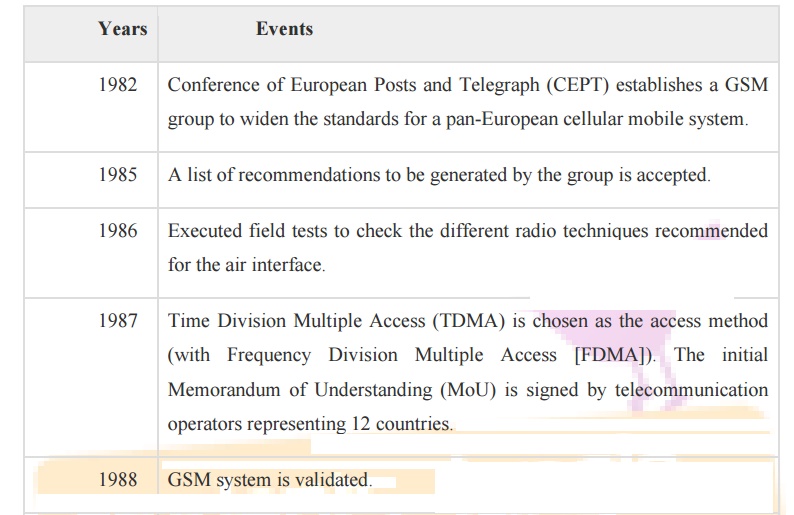

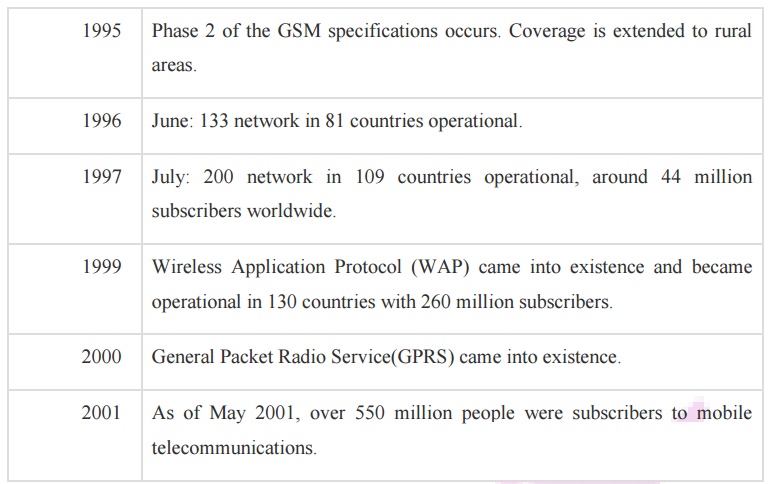
A GSM network comprises of many functional units.
These functions and interfaces are explained in this chapter. The GSM network
can be broadly divided into:
• The Mobile Station (MS)
• The Base Station Subsystem (BSS)
• The Network Switching Subsystem (NSS)
• The Operation Support Subsystem (OSS)
Given
below is a simple pictorial view of the GSM architecture.
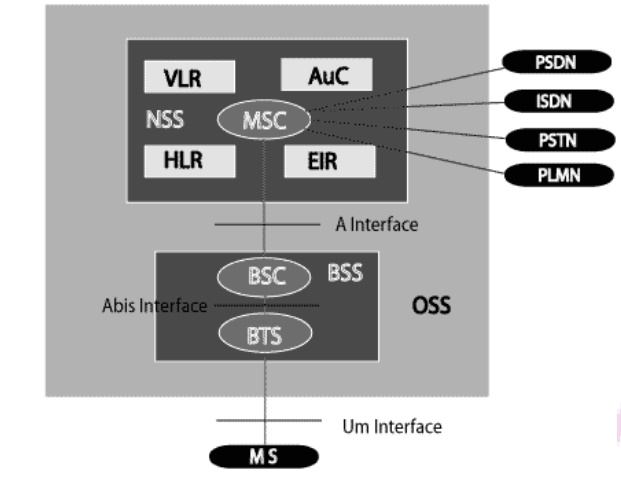
The
additional components of the GSM architecture comprise of databases and
messaging systems functions:
·
Home Location Register (HLR)
·
Visitor Location Register (VLR)
·
Equipment Identity Register (EIR)
·
Authentication Center (AuC)
·
SMS Serving Center (SMS SC)
·
Gateway MSC (GMSC)
·
Chargeback Center (CBC)
·
Transcoder and Adaptation Unit (TRAU)
The
following diagram shows the GSM network along with the added elements:
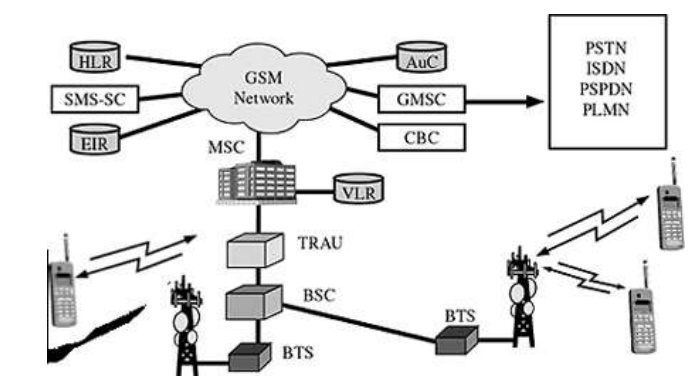
The MS
and the BSS communicate across the Um interface. It is also known as the air
interface or the radio link. The BSS communicates with the Network Service
Switching (NSS) center across the A interface.
GSM network areas
In a GSM
network, the following areas are defined:
Cell : Cell is the basic service area;
one BTS covers one cell. Each cell is given a Cell Global Identity (CGI), a number that uniquely identifies the cell.
Location Area : A group of cells form a
Location Area (LA). This is the area that is paged when a subscriber gets an incoming call. Each LA is assigned a
Location Area Identity (LAI). Each LA is served by one or more BSCs.
MSC/VLR Service Area : The
area covered by one MSC is called the MSC/VLR service
area.
PLMN : The area covered by one network
operator is called the Public Land Mobile
Network (PLMN). A PLMN can contain one or more MSCs.
GSM protocol stack
GSM
architecture is a layered model that is designed to allow communications
between two different systems. The lower layers assure the services of the
upper-layer protocols. Each layer passes suitable notifications to ensure the
transmitted data has been formatted, transmitted, and received accurately.
The GMS
protocol stacks diagram is shown below:
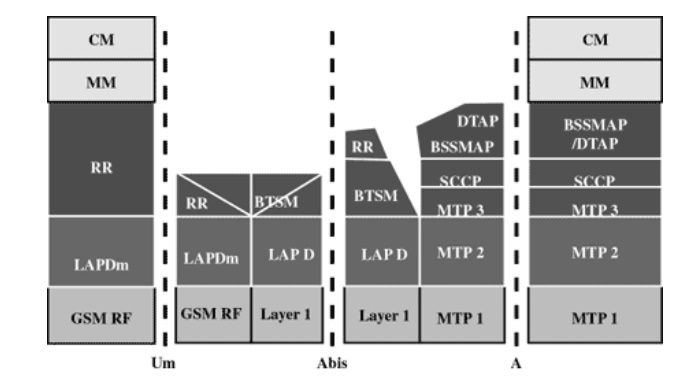
MS Protocols
Based on
the interface, the GSM signalling protocol is assembled into three general
layers:
Layer 1 : The physical layer. It uses the
channel structures over the air interface.
Layer 2 : The data-link layer. Across the
Um interface, the data-link layer is a modified version of the Link access protocol for the D channel (LAP-D)
protocol used in ISDN, called Link access protocol on the Dm channel (LAP-Dm).
Across the A interface, the Message Transfer Part (MTP), Layer 2 of SS7 is
used.
Layer 3 : GSM
signalling protocol‘s third layer is divided into three sublayers: o Radio Resource Management (RR),
o Mobility Management (MM), and
o Connection Management (CM).
MS to BTS Protocols
The RR
layer is the lower layer that manages a link, both radio and fixed, between the
MS and the MSC. For this formation, the main components involved are the MS,
BSS, and MSC. The responsibility of the RR layer is to manage the RR-session,
the time when a mobile is in a dedicated mode, and the radio channels including
the allocation of dedicated channels.
The MM
layer is stacked above the RR layer. It handles the functions that arise from
the mobility of the subscriber, as well as the authentication and security
aspects. Location management is concerned with the procedures that enable the
system to know the current location of a powered-on MS so that incoming call
routing can be completed.
The CM
layer is the topmost layer of the GSM protocol stack. This layer is responsible
for Call Control, Supplementary Service Management, and Short Message Service
Management. Each of these services are treated as individual layer within the
CM layer. Other functions of the CC sub layer include call establishment,
selection of the type of service (including alternating between services during
a call), and call release.
BSC Protocols
The BSC
uses a different set of protocols after receiving the data from the BTS. The
Abis interface is used between the BTS and BSC. At this level, the radio
resources at the lower portion of Layer 3 are changed from the RR to the Base
Transceiver Station Management (BTSM). The BTS management layer is a relay
function at the BTS to the BSC.
The RR
protocols are responsible for the allocation and reallocation of traffic
channels between the MS and the BTS. These services include controlling the
initial access to the system, paging for MT calls, the handover of calls
between cell sites, power control, and call termination. The BSC still has some
radio resource management in place for the frequency coordination, frequency
allocation, and the management of the overall network layer for the Layer 2
interfaces.
To
transit from the BSC to the MSC, the BSS mobile application part or the direct
application part is used, and SS7 protocols is applied by the relay, so that
the MTP 1-3 can be used as the prime architecture.
MSC Protocols
At the
MSC, starting from the BSC, the information is mapped across the A interface to
the MTP Layers 1 through 3. Here, Base Station System Management Application
Part (BSS MAP) is said to be the equivalent set of radio resources. The relay
process is finished by the layers that are stacked on top of Layer 3 protocols,
they are BSS MAP/DTAP, MM, and CM. This completes the relay process.
To find
and connect to the users across the network, MSCs interact using the
control-signalling network. Location registers are included in the MSC
databases to assist in the role of determining how and whether connections are
to be made to roaming users.Each GSM MS user is given a HLR that in turn
comprises of the user‘s location and subscribed services.
VLR is a
separate register that is used to track the location of a user.
When the
users move out of the HLR covered area, the VLR is notified by the MS to find
the location of the user. The VLR in turn, with the help of the control
network, signals the HLR of the MS‘s new location. With the help of location
information contained in the user‘s HLR, the MT calls can be routed to the
user.
GSM addressing
GSM
treats the users and the equipment in different ways. Phone numbers,
subscribers, and equipment identifiers are some of the known ones. There are
many other identifiers that have been well-defined, which are required for the
subscriber‘s mobility management and for addressing the remaining network
elements. Vital addresses and identifiers that are used in GSM are addressed
below.
International Mobile Station
Equipment Identity (IMEI)
The
International Mobile Station Equipment Identity (IMEI) looks more like a serial
number which distinctively identifies a mobile station internationally. This is
allocated by the equipment manufacturer and registered by the network operator,
who stores it in the Entrepreneurs-in-Residence (EIR). By means of IMEI, one
recognizes obsolete, stolen, or non-functional equipment.
Following
are the parts of IMEI:
·
Type
Approval Code (TAC) : 6 decimal places, centrally assigned.
·
Final
Assembly Code (FAC) : 6 decimal places, assigned by the manufacturer.
·
Serial
Number (SNR) : 6 decimal places, assigned by the manufacturer.
·
Spare
(SP) : 1 decimal place.
Thus,
IMEI = TAC + FAC + SNR + SP. It uniquely characterizes a mobile station and
gives clues about the manufacturer and the date of manufacturing.
International Mobile Subscriber
Identity (IMSI)
Every
registered user has an original International Mobile Subscriber Identity (IMSI)
with a valid IMEI stored in their Subscriber Identity Module (SIM).
IMSI
comprises of the following parts:
·
Mobile
Country Code (MCC) : 3 decimal places, internationally standardized.
·
Mobile
Network Code (MNC) : 2 decimal places, for unique identification of mobile network within the country.
·
Mobile
Subscriber Identification Number (MSIN) : Maximum 10 decimal places, identification number of the
subscriber in the home mobile network.
Mobile Subscriber ISDN Number
(MSISDN)
The
authentic telephone number of a mobile station is the Mobile Subscriber ISDN
Number (MSISDN). Based on the SIM, a mobile station can have many MSISDNs, as
each subscriber is assigned with a separate MSISDN to their SIM respectively.
Listed
below is the structure followed by MSISDN categories, as they are defined based
on international ISDN number plan:
Country Code (CC) : Up to 3
decimal places.
·
National
Destination Code (NDC) : Typically 2-3 decimal places.
·
Subscriber
Number (SN) : Maximum 10 decimal places.
Mobile Station Roaming Number (MSRN)
Mobile
Station Roaming Number (MSRN) is an interim location dependent ISDN number,
assigned to a mobile station by a regionally responsible Visitor Location
Register (VLA). Using MSRN, the incoming calls are channelled to the MS.
The MSRN
has the same structure as the MSISDN.
·
Country
Code (CC) : of the visited network.
·
National
Destination Code (NDC) : of the visited network.
·
Subscriber
Number (SN) : in the current mobile network.
Location Area Identity (LAI)
Within a
PLMN, a Location Area identifies its own authentic Location Area Identity
(LAI). The LAI hierarchy is based on international standard and structured in a
unique format as mentioned below:
·
Country
Code (CC) : 3 decimal places.
·
Mobile
Network Code (MNC) : 2 decimal places.
·
Location
Area Code (LAC) : maximum 5 decimal places or maximum twice 8 bits coded in hexadecimal (LAC < FFFF).
Temporary Mobile Subscriber Identity
(TMSI)
Temporary
Mobile Subscriber Identity (TMSI) can be assigned by the VLR, which is
responsible for the current location of a subscriber. The TMSI needs to have
only local significance in the area handled by the VLR. This is stored on the
network side only in the VLR and is not passed to the Home Location Register
(HLR).
Together
with the current location area, the TMSI identifies a subscriber uniquely. It
can contain up to 4 × 8 bits.
Local Mobile Subscriber Identity
(LMSI)
Each
mobile station can be assigned with a Local Mobile Subscriber Identity (LMSI),
which is an original key, by the VLR. This key can be used as the auxiliary
searching key for each mobile station within its region. It can also help
accelerate the database access. An LMSI is assigned if the mobile station is
registered with the VLR and sent to the HLR. LMSI comprises of four octets (4x8
bits).
Cell Identifier (CI)
Using a
Cell Identifier (CI) (maximum 2 × 8) bits, the individual cells that are within
an LA can be recognized. When the Global Cell Identity (LAI + CI) calls are
combined, then it is uniquely defined.
GSM security
GSM is
the most secured cellular telecommunications system available today. GSM has
its security methods standardized. GSM maintains end-to-end security by
retaining the confidentiality of calls and anonymity of the GSM subscriber.
Temporary
identification numbers are assigned to the subscriber‘s number to maintain the
privacy of the user. The privacy of the communication is maintained by applying
encryption algorithms and frequency hopping that can be enabled using digital
systems and signalling.
Mobile Station Authentication
The GSM
network authenticates the identity of the subscriber through the use of a
challenge-response mechanism. A 128-bit Random Number (RAND) is sent to the MS.
The MS computes the 32-bit Signed Response (SRES) based on the encryption of
the RAND with the authentication algorithm (A3) using the individual subscriber
authentication key (Ki). Upon receiving the SRES from the subscriber, the GSM
network repeats the calculation to verify the identity of the subscriber.
The
individual subscriber authentication key (Ki) is never transmitted over the
radio channel, as it is present in the subscriber's SIM, as well as the AUC,
HLR, and VLR databases. If the received SRES agrees with the calculated value,
the MS has been successfully authenticated and may continue. If the values do
not match, the connection is terminated and an authentication failure is
indicated to the MS.
The
calculation of the signed response is processed within the SIM. It provides
enhanced security, as confidential subscriber information such as the IMSI or
the individual subscriber authentication key (Ki) is never released from the
SIM during the authentication process.
Signalling and Data Confidentiality
The SIM
contains the ciphering key generating algorithm (A8) that is used to produce
the 64-bit ciphering key (Kc). This key is computed by applying the same random
number (RAND) used in the authentication process to ciphering key generating
algorithm (A8) with the individual subscriber authentication key (Ki).
GSM
provides an additional level of security by having a way to change the ciphering
key, making the system more resistant to eavesdropping. The ciphering key may
be changed at regular
intervals as required.
As in case
of the authentication process,
the
computation
of the ciphering key (Kc) takes place internally within the SIM. Therefore,
sensitive
information such as the individual subscriber authentication key (Ki) is never
revealed
by the SIM.
Encrypted voice
and data communications between
the MS and
the network is
accomplished
by using the ciphering algorithm A5. Encrypted communication is initiated by
a
ciphering mode request command from the GSM network. Upon receipt of this
command,
the
mobile station begins encryption and decryption of data using the ciphering
algorithm
(A5) and
the ciphering key (Kc).
Subscriber Identity Confidentiality
To ensure
subscriber identity confidentiality, the
Temporary Mobile Subscriber
Identity
(TMSI) is used. Once the authentication and encryption procedures are done, the
TMSI is
sent to the mobile station. After the receipt, the mobile station responds. The
TMSI
is valid
in the location area in which it was issued. For communications outside the
location
area, the
Location Area Identification (LAI) is necessary in addition to the TMSI.
GSM Billing
GSM
service providers are doing billing based on the services they are providing to
their customers. All the parameters are simple enough to charge a customer for
the provided services.
Telephony Service
These
services can be charged on per call basis. The call initiator has to pay the
charges, and the incoming calls are nowadays free. A customer can be charged
based on different parameters such as:
·
International call or long distance call.
·
Local call.
·
Call made during peak hours.
·
Call made during night time.
·
Discounted call during weekends.
·
Call per minute or per second.
·
Many more other criteria can be designed by a
service provider to charge their customers.
SMS Service
Most of
the service providers charge their customer's SMS services based on the number
of text messages sent. There are other prime SMS services available where
service providers charge more than normal SMS charge. These services are being
availed in collaboration of Television Networks or Radio Networks to demand SMS
from the audiences.
Most of
the time, the charges are paid by the SMS sender but for some services like
stocks and share prices, mobile banking facilities, and leisure booking
services, etc. the recipient of the SMS has to pay for the service.
GPRS Services
Using
GPRS service, you can browse, play games on the Internet, and download movies.
So a service provider will charge you based on the data uploaded as well as
data downloaded on your mobile phone. These charges will be based on per Kilo
Byte data downloaded/uploaded.
Additional
parameter could be a QoS provided to you. If you want to watch a movie, then a
low QoS may work because some data loss may be acceptable, but if you are
downloading a zip file, then a single byte loss will corrupt your complete
downloaded file.Another parameter could be peak and off peak time to download a
data file or to browse the Internet.
Supplementary Services
Most of
the supplementary services are being provided based on monthly rental or
absolutely free. For example, call waiting, call forwarding, calling number
identification, and call on hold are available at zero cost.
Call
barring is a service, which service providers use just to recover their dues,
etc., otherwise this service is not being used by any subscriber. Call conferencing
service is a form of simple telephone call where the customers are charged for
multiple calls made at a time. No service provider charges extra charge for
this service.
Closed
User Group (CUG) is very popular and is mainly being used to give special
discounts to the users if they are making calls to a particular defined group
of subscribers. Advice of Charge (AoC) can be charged based on number of
queries made by a subscriber.
Related Topics